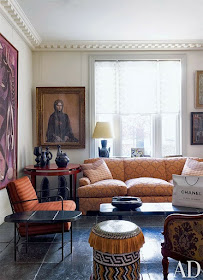If you are familiar with Kenny Scharf's work, you know he is inexplicably identified with his crazy cartoon characters. Alongside Keith Haring and Jean-Michael Basquiat and under the tutelage of Andy Warhol, Kenny was considered a key figure in the pop art/post punk culture of New York in the 80's.
Kenny's Jetsons meets Flintstones cartoon(ish) characters that look like they are moving through a lava lamp, often on outer space backgrounds as they have been described, express hope, joy, optimism and FUN! I can tell you first hand Kenny also has them tattooed on his body.
 |
| "Fred and Wilma in Heaven" 1980 |
 |
| "213" |
 |
| "OLA" 2005 |
 |
| "Space and Blob" 2004 |
Kenny began his career as a graffiti artist, and maybe that's why his characters morphed into the perfect street style subjects. I bet a mural can be seen somewhere in the world at any given time.
 |
| Pasadena Art Center College School of Design, mural arts, 2015 |
The man photobombs cars and has his own carasouel.
 |
| LUNA LUNA 1987 |
I really enjoy his donut series:YUM
I had a special interest in meeting Kenny. It took a little doing, but eventually we connected and he invited us to his studio. He said it was hard to find, but we pretty much figured it out : )
We sat along side him while he painted. He is getting ready for a few shows. Art Walk will be honoring Kenny next month, and MOMA is exhibiting him next year in a group show. The man is busy!
I asked Kenny what he remembered most about his years spent in NY in the 80's, living with Keith Harring, clubing and doing the whole underground thing. His response was, "death." They are inexplicably tied together. The loss of so many friends overshadowed everything.
 |
| Andy Warhol, Jacqueline Schnabel, Jean-Michel Basquiat,Julian Schnabel Kenny Scharf, NY 1984 ph via: ArtHolics |
We spent an hour or so in another dimension, and I was transported back to my middle school years when I loved watching The Flintstones! I could sing with Ann Margrock; "I love you, but I ain't gonna be a fool" and wondered if I could rock a bone in my hair? It was apropos as we went back in time, the men telling childhood stories and weaving the family tree together.
Kenny and Steven are cousins.
Photos:Kenny Scharf , CLI













































